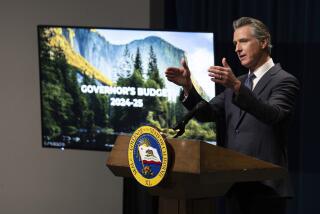Many Face Cutoff of Jobless Benefits
- Share via
WASHINGTON — Policymakers have known for decades that the nation’s shambling unemployment insurance system is in need of repair.
But like the grasshopper in the children’s story who fails to prepare for winter, they have refused to act until the winds of recession and layoff are swirling around them.
Now, Congress and the White House have gone it one better. The former has effectively decided there’s no big problem after all. The latter has concluded that, even if there is, there’s no rush to solve it. The result is that nearly a million Americans risk losing unemployment benefits just after Christmas.
“Talk about a kick in the gut,” said Pat Zanon, a divorced mother of three who was laid off in the spring after 24 years with Denver-based Qwest Communications Inc. and is collecting the so-called extended benefits that Washington is letting expire.
“It was going to be a bleak Christmas anyway because with unemployment you don’t get that much,” said 59-year-old Zanon, who has gone from making $1,000 a week to getting by on about $300. “But now it’s really going to be bleak.”
To be fair, White House aides say the administration is trying to come up with something for people such as Zanon who have been jobless for more than six months and have run out of their regular, state-funded benefits. Labor Department officials say that if Congress acts quickly when it returns Jan. 7, there’s still a chance that unemployed workers could avoid missing a check. But the fact is that the administration refused to step in to break the congressional deadlock that will bring an end to extended benefits. And there is considerable sentiment, especially among House Republicans, that there is no more need for the extra aid.
While suggesting that the president may support some additional assistance, the senior administration official said Bush’s aides are hard at work on an “innovative, new approach” to unemployment insurance -- one that, it appears, would only indirectly address the most glaring problems with the jobless benefits system.
That system, the product of the New Deal, is a hybrid in which states set most of the rules for who gets benefits and how much, while Washington pays administrative bills and kicks in extra benefits when times are tough. It all worked as long as layoffs were short and work patterns were similar. And the setup had an added advantage: With a national “trigger” turning on extra benefits during recessions and turning them off in recoveries, the system acted as an automatic stabilizer to help the economy regain its balance.
Then came the 1980s. To cut costs, Washington dropped the national trigger; that took the “automatic” out of the stabilizer. To meet foreign competition, employers eliminated positions; workers who lost their jobs were out for longer periods. And as the economy changed, so did the nature of work in America.
The combination played havoc with the jobless benefits system, forcing states to tighten rules and keeping an ever-larger fraction of workers from collecting benefits. Government statistics show that 75% of the unemployed collected benefits in the mid-1970s recession, but only 45% are doing so now.
“Essentially, what we’ve ended up with is an unemployment compensation system that doesn’t deal with many people who are unemployed,” said former Rep. Thomas J. Downey (D-N.Y.), who tried, but failed, to fix many of the system’s problems in the early 1990s.
Subsequently, a commission appointed by the first President Bush produced several thick volumes of recommended repairs. Asked recently whether any of its proposals were adopted, panel chairwoman Janet Norwood said, “None that I’m aware of.”
So what does the current President Bush suggest?
Only part of the administration’s “innovative, new” proposal is in public view. That involves shifting the costs and responsibilities for administering the jobless benefits system back to the states. The idea was popular with governors in the flush 1990s, but now -- with states facing their worst budget crisis since World War II -- it seems impossibly out of date.
Other elements can be inferred. The Labor Department, for instance, is known to be interested in “adjustment accounts,” money that people could use to live on or pay for training while jobless. They then would keep whatever money is left once they are employed.
This has the appeal of offering a solution to what many in the administration see as a critical problem with the current system by rewarding efforts to get a new job quickly. But critics say this approach would require so many rules it would barely differ from what exists now. At most, it would begin with pilot projects in a few states.
Finally, there’s the issue of extended benefits. The president has yet to show his hand, but many in his party argue that all that’s needed is a few extra weeks of benefits to let those now collecting down gently.
But don’t tell that to Timothy Lech, a purchasing agent for foundry equipment maker CSI Industrial Systems Corp. in Grayling, Mich., before the company shut down in June.
Lech, who is collecting extended benefits, says he’s been looking for a job for six months. So has his grown son, who has six children younger than 7 and also worked at CSI.
The family has decided to pass on Christmas this year. “We talked about it and said there’s no sense putting anybody in a bind,” he said. “We just hope next year’s better.”
More to Read
Get the L.A. Times Politics newsletter
Deeply reported insights into legislation, politics and policy from Sacramento, Washington and beyond. In your inbox twice per week.
You may occasionally receive promotional content from the Los Angeles Times.










